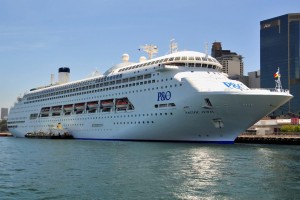Until recent decades, toilets and showers on large ocean going vessels used sea water for everything, as the energy and equipment required to desalinate sea water was cost-prohibitive. The resulting rust and corrosion of plumbing and fixtures was an ongoing concern, as were blocked valves and fittings. Today’s cruise ships use potable water in toilets and showers, thanks to engineering ingenuity resulting in onboard water desalination systems.
Ocean water desalination plants remove salt and impurities from sea water, rendering it safe for human consumption, providing a much more pleasant cruising experience. Sea water is still used for engine cooling systems by combining it with coolant and fresh water which is circulated through a heat exchanger and back to the engine.
How does the desalination system work?
In a method that mimics nature, where evaporated sea water falls as rain, the onboard system uses osmosis, which uses a fine membrane to filter sea water, separating minerals and salt. A benefit of this system is that cruise ships can desalinate sea water anywhere in the ocean, avoiding any form of near-coastal water contamination.
Once the water is desalinated, it flows through a mineralisation system which adds healthy minerals commonly found in regular drinking water. The water is then tested for impurities and corrected to meet appropriate pH levels. From here the water is piped to huge tanks, with some cruise ships storing around 2 million litres of fresh water.

A cruise ship is a huge vessel with many kilometres of pipes that distribute water around the ship to hot and cold systems. Once the water has served its purpose in a toilet or shower it is again treated before discharging according to stringent environmental guidelines. The waste water is never released close to port or near sensitive marine environments. The entire process is complex and expensive, but cruise ships are deservedly gaining a reputation as caretakers of our great oceans.
The ocean can be a harsh environment leading to dehydration, and drinking and bathing water is essential for health and vitality. Fresh, desalinated water has helped cruise lines establish high levels of hygiene along with passenger convenience for accomplishing daily activities. A reliable supply of water is required everywhere on a cruise ship, not only for bathing and washing, but also for the ship’s kitchens, where enormous feasts are created on a daily basis.
Desalinated water on a cruise ship contains a very low salt content, measuring less than five parts per million. Backup water heating systems for desalination include using oil-fired boilers, which although uneconomical in the long run, ensure that there is always an ample supply of fresh water for everyone onboard a cruise ship.
Image credit: Brian Hoffsis and CruiseSource.us




